Bio-based Leather Trends and Forecast
The future of the global bio-based leather market looks promising with opportunities in the footwear, furnishing, automotive, clothing, bags and wallet, sport, and electronic markets. The global bio-based leather market is expected to reach an estimated $1,279.1 million by 2030 with a CAGR of 6.3% from 2024 to 2030. The major drivers for this market are the rising consumer awareness towards eco-friendly products, growing concern about animal welfare, and on-going advancements in the manufacturing process of bio-based leather.
• Lucintel forecasts that, within the source category, pineapple is expected to witness the highest growth over the forecast period due to its ease of use and sustainability.
• Within the application category, footwear will remain the largest segment.
• In terms of region, APAC is expected to witness the highest growth over the forecast period due to growing demand for fashion products and accessories and rising investment in research and development of bio-based materials.
Gain valuable insights for your business decisions with our comprehensive 150+ page report.
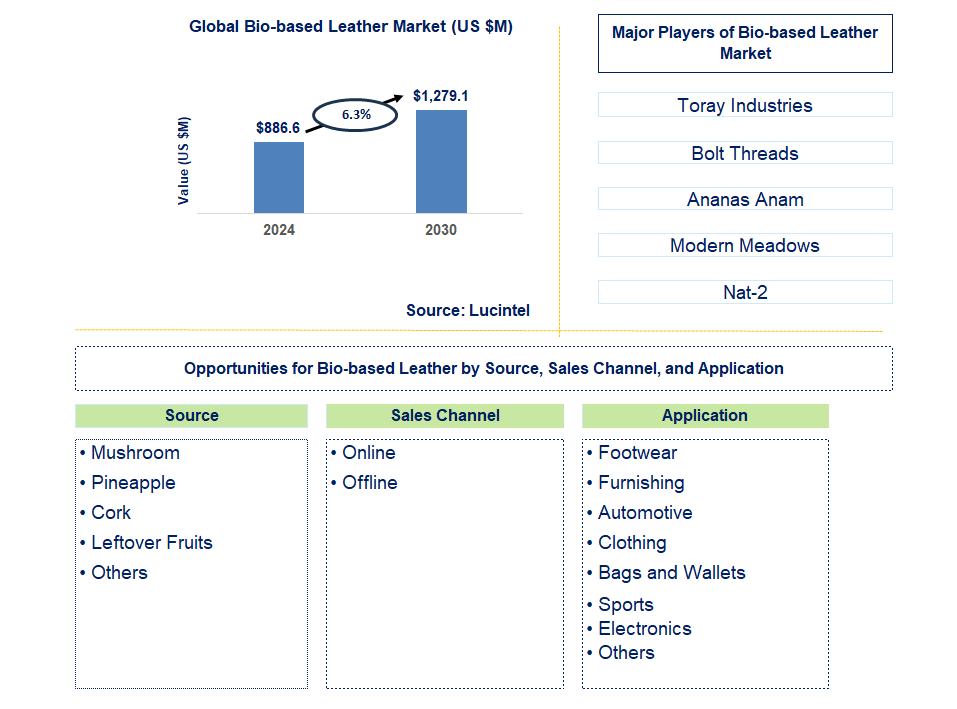
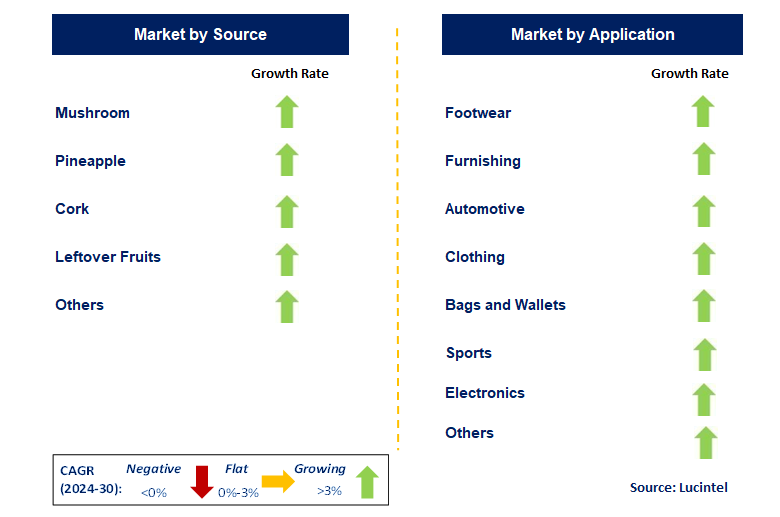
Emerging Trends in the Bio-based Leather Market
Emerging trends in bio-based leather highlight significant advancements and evolving market demands. These trends are reshaping the industry by enhancing material properties and expanding applications, driven by sustainability and innovation.
• Increased Use of Plant-Based Materials: Plant-based materials like pineapple leaves and apple peels are gaining popularity. These materials offer a sustainable alternative to traditional leather, providing eco-friendly options that cater to the growing demand for environmentally responsible products.
• Development of Mycelium-Based Leathers: Fungal-based leathers derived from mycelium are emerging as high-performance alternatives. Mycelium-based leathers offer durability and versatility while reducing environmental impact, making them promising options for various applications.
• Integration with Circular Economy Principles: Bio-based leather is increasingly being designed with circular economy principles in mind. Products are being developed to be recyclable or biodegradable, aligning with sustainability goals and reducing waste in the fashion and furniture industries.
• Customization and Aesthetic Innovations: Advances in dyeing and finishing techniques are expanding the aesthetic possibilities of bio-based leather. This trend enhances the material’s appeal and versatility, making it suitable for a wider range of applications, from fashion to interiors.
• Collaborative Research and Development: Collaborations between companies, research institutions, and governments are accelerating bio-based leather innovation. These partnerships focus on improving material properties, and production processes, and scaling up manufacturing capabilities, driving industry growth.
These trends are reshaping the bio-based leather industry by driving innovation and expanding applications. The focus on sustainability, performance, and collaboration is enhancing the material’s market potential and adoption across various sectors.
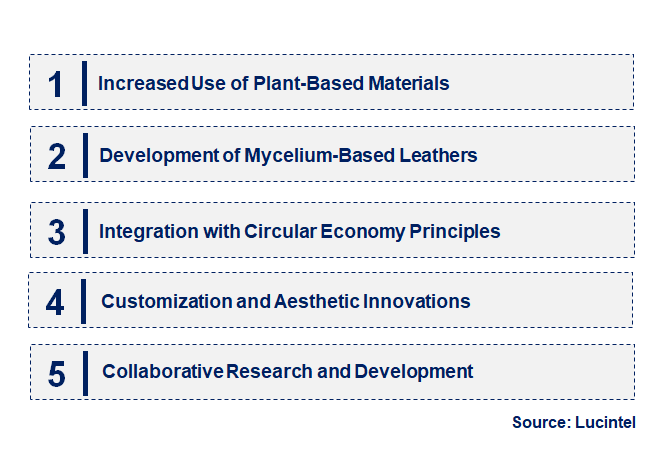
Recent Developments in the Bio-based Leather Market
Recent key developments in bio-based leather highlight advancements in technology and market growth. These developments enhance material properties, expand applications, and support the transition to more sustainable alternatives.
• Introduction of Plant-Based Leathers: New plant-based leathers, such as those made from pineapple leaves and apple peels, are gaining traction. These materials offer a sustainable alternative to traditional leather and are being adopted in fashion and consumer goods.
• Advancements in Mycelium-Based Leathers: Mycelium-based leathers are being developed with improved properties and applications. These innovations provide high-performance, sustainable alternatives to conventional leather, with applications in fashion, automotive, and furniture.
• Improved Production Technologies: Innovations in production technologies are enhancing the efficiency and scalability of bio-based leather manufacturing. These advancements make it easier to meet growing demand and reduce production costs.
• Increased Consumer Adoption: Growing consumer awareness and demand for sustainable products are driving the adoption of bio-based leather. Brands are incorporating these materials into their product lines, reflecting a shift toward eco-friendly fashion and design.
• Collaborative Industry Initiatives: Industry collaborations and partnerships are accelerating the development and commercialization of bio-based leather. These initiatives focus on improving material performance, production processes, and market reach.
These developments are advancing the bio-based leather industry by improving material properties, scaling up production, and increasing market adoption. The sector is evolving to meet the growing demand for sustainable alternatives and address environmental challenges.
Strategic Growth Opportunities for Bio-based Leather Market
Strategic growth opportunities in bio-based leather reflect the industry’s potential to expand across various applications. Technological advancements and shifting market demands are creating new avenues for growth and innovation.
• Fashion Industry: The fashion industry offers significant growth potential for bio-based leather. Increasing consumer demand for sustainable and ethical fashion is driving the adoption of bio-based materials for apparel, accessories, and footwear.
• Automotive Interiors: Bio-based leather is gaining traction in automotive interiors, where its sustainability and durability are valued. Automakers are exploring its use for seats, dashboards, and trim, aligning with their environmental goals and consumer preferences.
• Furniture and Upholstery: The furniture sector presents growth opportunities for bio-based leather, particularly for upholstery and decorative elements. Its versatility and eco-friendly properties make it an attractive option for sustainable design.
• Consumer Goods: Bio-based leather is expanding into consumer goods, such as bags, wallets, and phone cases. The increasing demand for sustainable accessories is driving innovation and adoption in this market.
• Industrial Applications: Bio-based leather is finding applications in industrial sectors, including protective gear and equipment covers. Its durability and performance make it suitable for various industrial uses, supporting broader market adoption.
These strategic growth opportunities are expanding the applications and market potential of bio-based leather. The industry is responding to technological advancements and consumer preferences, driving innovation and adoption across multiple sectors.
Bio-based Leather Market Driver and Challenges
The bio-based leather market is shaped by several drivers and challenges, including technological advancements, economic factors, and regulatory requirements. Understanding these influences is crucial for navigating the market and achieving growth.
The factors driving the bio-based leather market include:
• Technological Advancements: Innovations in material science and production technologies are driving growth in bio-based leather. These advancements improve performance, durability, and sustainability, expanding the material’s applications and market potential.
• Increasing Consumer Demand for Sustainability: Rising consumer awareness and demand for eco-friendly products fuel the bio-based leather market. Consumers’ preference for sustainable alternatives to traditional leather encourages companies to invest in and develop bio-based solutions.
• Supportive Regulatory Frameworks: Regulatory support for sustainable and green technologies promotes the growth of bio-based leather. Policies and incentives that encourage the use of eco-friendly materials facilitate market expansion and innovation.
• Investment in Research and Development: Increased investment in R&D advances the bio-based leather sector. Companies and research institutions focus on improving material properties, developing new applications, and enhancing production processes.
• Collaborations and Partnerships: Collaborative efforts between companies, research institutions, and governments accelerate innovation in bio-based leather. These partnerships focus on enhancing material properties, scaling up production, and expanding market reach.
Challenges in the bio-based leather market include:
• Higher Production Costs: The production costs of bio-based leather can be higher than traditional leather due to complex manufacturing processes and raw material expenses. This can affect pricing and market competitiveness.
• Limited Availability of Raw Materials: The availability of raw materials for bio-based leather is constrained, impacting production capacity and costs. Ensuring a steady supply of high-quality materials poses a challenge for the industry.
• Consumer Perception and Acceptance: Consumer perception of bio-based leather varies, which can affect market adoption. Educating consumers about the benefits and quality of bio-based leather is essential for driving demand.
• Scalability of Production: Scaling up production to meet the growing demand for bio-based leather can be challenging. Efficient and cost-effective manufacturing processes are crucial for expanding market reach.
• Regulatory Hurdles: Navigating regulatory requirements for bio-based leather can be complex. Compliance with various regulations and standards poses a challenge for manufacturers and can impact market entry.
These drivers and challenges shape the bio-based leather market, influencing its growth and development. Addressing these factors effectively is essential for advancing technology, meeting market demands, and achieving sustainability goals.
List of Bio-based Leather Companies
Companies in the market compete on the basis of product quality offered. Major players in this market focus on expanding their manufacturing facilities, R&D investments, infrastructural development, and leverage integration opportunities across the value chain. With these strategies bio-based leather companies cater increasing demand, ensure competitive effectiveness, develop innovative products & technologies, reduce production costs, and expand their customer base. Some of the bio-based leather companies profiled in this report include-
• Toray Industries
• Bolt Threads
• Ananas Anam
• Modern Meadows
• Nat-2
• Natural Fiber Welding
• Ultra fabrics
• MycoWorks
• ECCO Leather
• VEGEA
Bio-based Leather by Segment
The study includes a forecast for the global bio-based leather market by source, sales channel, application, and region.
Bio-based Leather Market by Source [Analysis by Value from 2018 to 2030]:
• Mushroom
• Pineapple
• Cork
• Leftover Fruits
• Others
Bio-based Leather Market by Sales Channel [Analysis by Value from 2018 to 2030]:
• Online
• Offline
Bio-based Leather Market by Application [Analysis by Value from 2018 to 2030]:
• Footwear
• Furnishing
• Automotive
• Clothing
• Bags and Wallets
• Sports
Bio-based Leather Market by Region [Analysis by Value from 2018 to 2030]:
• North America
• Europe
• Asia Pacific
• The Rest of the World
Country Wise Outlook for the Bio-based Leather Market
Major players in the market are expanding their operations and forming strategic partnerships to strengthen their positions. The following highlights recent developments by major bio-based leather producers in key regions: the USA, China, India, Japan, and Germany.
• United States: In the U.S., bio-based leather has seen significant innovation, with several startups and established companies developing new plant-based and fungal-based materials. Increased investment in sustainable technologies and partnerships with fashion brands drive growth and adoption in the fashion and automotive sectors.
• China: China is scaling up the production of bio-based leather, focusing on integrating new technologies and improving manufacturing efficiency. The government’s support for green technologies and investments in research accelerate the development and commercialization of bio-based leather materials.
• Germany: Germany leads in high-quality bio-based leather innovation, emphasizing advanced production techniques and sustainable practices. German firms focus on applications in the fashion, automotive, and furniture industries, leveraging their expertise in precision engineering to enhance material performance and sustainability.
• India: In India, bio-based leather development is driven by a combination of domestic demand and export potential. Companies are investing in scalable production processes and exploring various bio-based materials to cater to both local and international markets, with a focus on affordability and sustainability.
• Japan: Japan is advancing bio-based leather technology with a focus on high-performance materials and aesthetics. Japanese companies integrate cutting-edge technologies to improve the quality and versatility of bio-based leather, addressing market demands in fashion, automotive, and consumer goods.
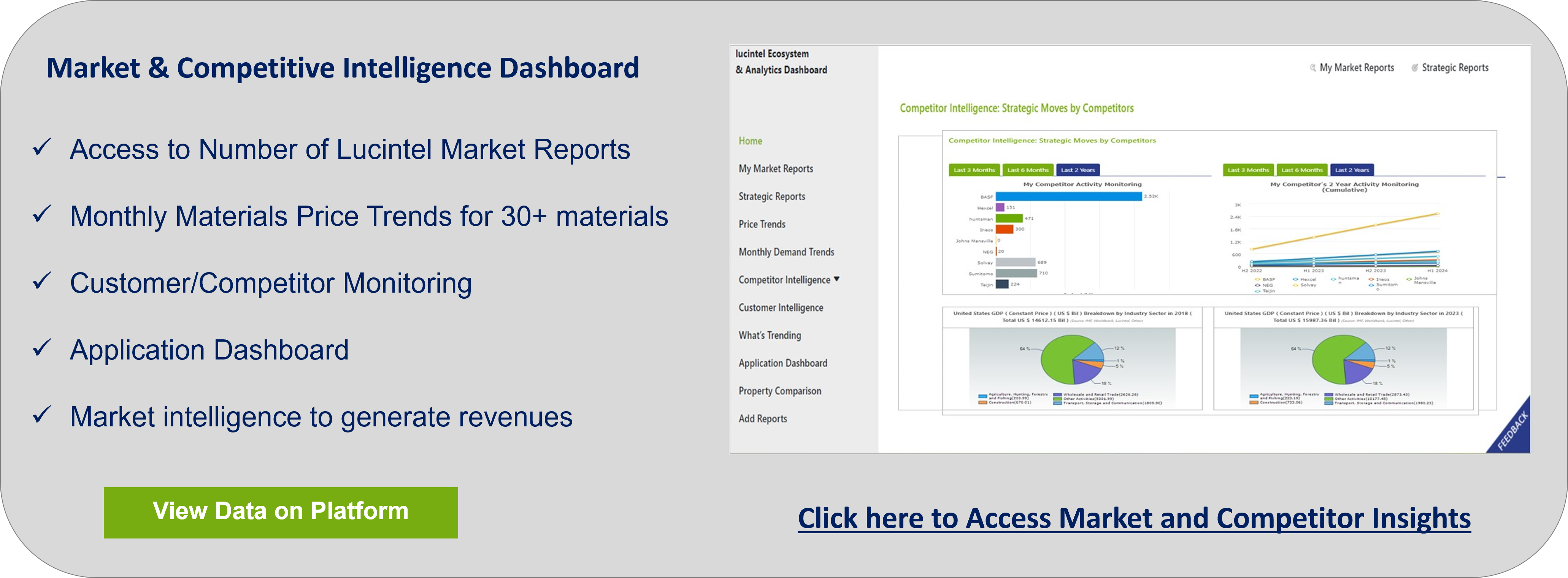
Features of the Global Bio-based Leather Market
Market Size Estimates: Bio-based leather market size estimation in terms of value ($M).
Trend and Forecast Analysis: Market trends (2018 to 2023) and forecast (2024 to 2030) by various segments and regions.
Segmentation Analysis: Bio-based leather market size by source, sales channel, application, and region in terms of value ($M).
Regional Analysis: Bio-based Leather Market breakdown by North America, Europe, Asia Pacific, and Rest of the World.
Growth Opportunities: Analysis of growth opportunities in different sources, sales channels, applications, and regions for the bio-based leather market.
Strategic Analysis: This includes M&A, new product development, and competitive landscape of the bio-based leather market.
Analysis of competitive intensity of the industry based on Porter’s Five Forces model.
If you are looking to expand your business in this market or adjacent markets, then contact us. We have done hundreds of strategic consulting projects in market entry, opportunity screening, due diligence, supply chain analysis, M & A, and more.
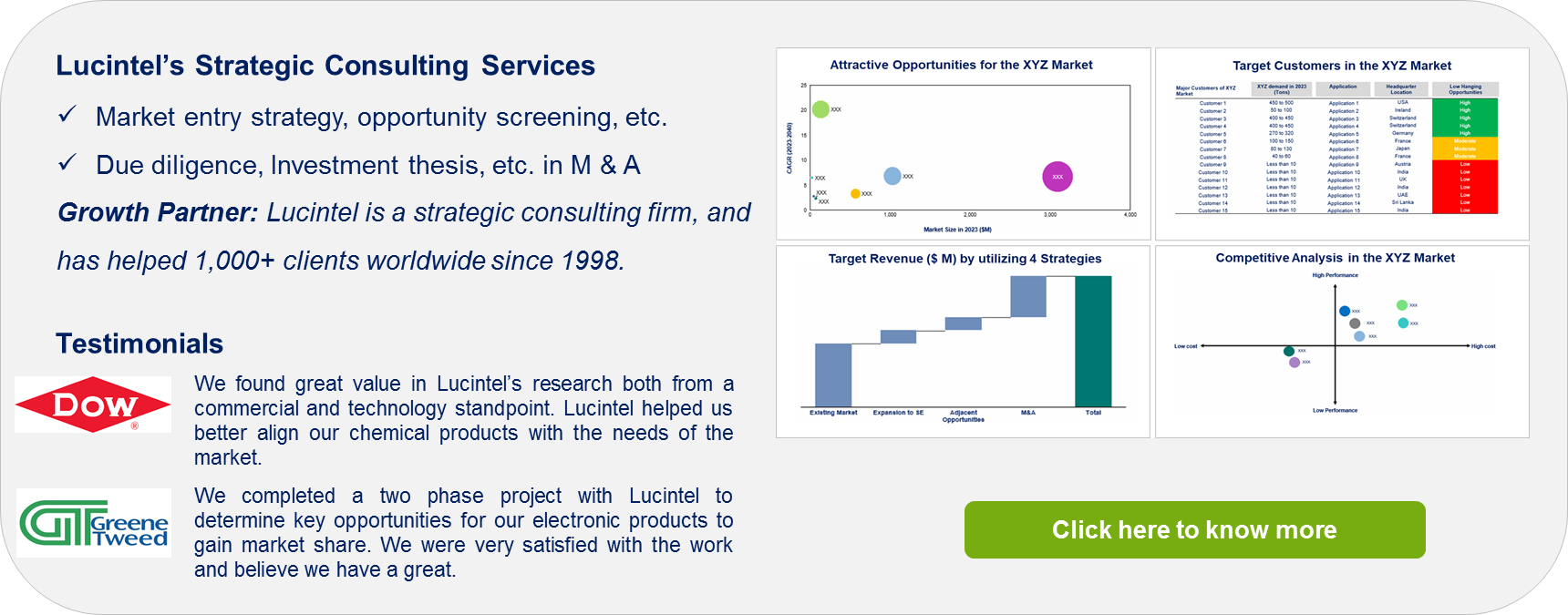
FAQ
Q.1 What is the bio-based leather market size?
Answer: The global bio-based leather market is expected to reach an estimated $1,279.1 million by 2030.
Q.2 What is the growth forecast for bio-based leather market?
Answer: The global bio-based leather market is expected to grow with a CAGR of 6.3% from 2024 to 2030
Q.3 What are the major drivers influencing the growth of the bio-based leather market?
Answer: The major drivers for this market are rising consumer awareness towards eco-friendly products, growing concern about animal welfare, and on-going advancements in the manufacturing process of bio-based leather.
Q4. What are the major segments forbio-based leather market?
Answer: The future of the global bio-based leather market looks promising with opportunities in the footwear, furnishing, automotive, clothing, bags and wallet, sport, and electronic markets.
Q5. Who are the key bio-based leather companies?
Answer: Some of the key bio-based leather companies are as follows:
• Toray Industries
• Bolt Threads
• Ananas Anam
• Modern Meadows
• Nat-2
• Natural Fiber Welding
• Ultra fabrics
• MycoWorks
• ECCO Leather
• VEGEA
Q6. Which bio-based leather market segment will be the largest in future?
Answer: Lucintel forecasts that pineapple is expected to witness the highest growth over the forecast period due to its ease of use and sustainability.
Q7. In bio-based leather market, which region is expected to be the largest in next 5 years?
Answer: APAC is expected to witness the highest growth over the forecast period due to growing demand of fashion products and accessories and rising investment in research and development of bio-based materials.
Q.8 Do we receive customization in this report?
Answer: Yes, Lucintel provides 10% customization without any additional cost.
This report answers following 11 key questions:
Q.1. What are some of the most promising, high-growth opportunities for the bio-based leather market by source (mushroom, pineapple, cork, leftover fruits, and others), sales channel (online and offline), application (footwear, furnishing, automotive, clothing, bags and wallets, sports, electronics, and others), and region (North America, Europe, Asia Pacific, and the Rest of the World)?
Q.2. Which segments will grow at a faster pace and why?
Q.3. Which region will grow at a faster pace and why?
Q.4. What are the key factors affecting market dynamics? What are the key challenges and business risks in this market?
Q.5. What are the business risks and competitive threats in this market?
Q.6. What are the emerging trends in this market and the reasons behind them?
Q.7. What are some of the changing demands of customers in the market?
Q.8. What are the new developments in the market? Which companies are leading these developments?
Q.9. Who are the major players in this market? What strategic initiatives are key players pursuing for business growth?
Q.10. What are some of the competing products in this market and how big of a threat do they pose for loss of market share by material or product substitution?
Q.11. What M&A activity has occurred in the last 5 years and what has its impact been on the industry?